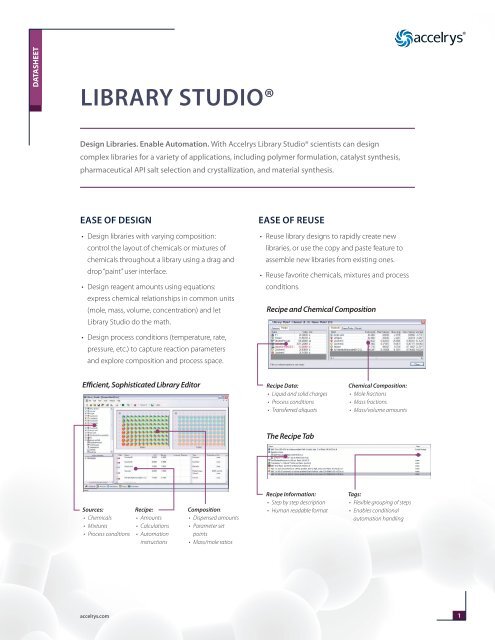
After stressing the polymer with UV light, acid, and oxidation we analyzed for chemical changes.
CHEMICAL COMPOSITION MATERIALS STUDIO SOFTWARE
Our Agilent software helped us confirm the compositions of the polyethylene, and also compared it to a list of other similar molecular candidates. In Chart 1, you can see differences between the HDPE, MDPE, and LLDPE polymers based on differences in the presence of certain chemical bonds.

After storing the spectroscopy results, we exposed the polymers to constant UV light for 12 days, re-analyzed the materials, and then exposed the polymers to acid and oxidation, taking a reading after each stressor. To demonstrate the FTIR’s ability to determine material compositions, we analyzed three polymers commonly used in medical device materials or packaging: High Density Polyethylene (HDPE), Medium Density Polyethylene (MDPE), and Linear Low Density Polyethylene (LLDPE). Case Study – A Comparison of PolyethylenesĪt Pacific Bio Labs, we utilize an Agilent Technologies Cary 630 FTIR to perform our spectroscopy. Therefore one can accurately determine the composition of an unknown material. With these two known values, one can calculate the total molecular makeup of a material, and compare it to similar materials on record. The vertical height of these peaks, meanwhile, reflects the amount of the material present. Different compounds peak at different locations on the horizontal axis, such as the 2349^-1 cm peak of Carbon Dioxide, or the 1450^-1-1380^-1 cm peak of Sulfate. In this way, one can isolate the FTIR signatures, and analyze what wavelengths are absorbed. FTIR in particular works by using multiple different frequencies in its beam, with each frequency reacting to the material in a different manner. This method is known as absorbance spectroscopy, and can be performed in a variety of ways, including shining a beam of light with a limited group of frequencies through a material, or using monochrome light. It also measures covalent bonding pairs and functional groups within a material.įTIR takes advantage of a material’s absorbance of light, using the way different molecular compounds react to the infrared beam in order to determine the makeup of the material under analysis. FTIR is useful for both organic and inorganic material. Using FTIR, one can analyze the chemical makeup of a material, by examining the chemical bonds and composition. Grimme’s GFN-xTB method highly efficient quantum tight-binding accuracy for elements up to Z = 86.Fourier-transformed infrared spectroscopy, also known as FTIR, is a method of analyzing both organic and inorganic materials, and can provide a breakdown of their molecular makeup.

Build clusters, nanotubes, surfaces and bulk (including MOFs & COFs).So you can study, at various levels of sophistication, the molecular and bulk properties of systems ranging from a few to a million atoms.
CHEMICAL COMPOSITION MATERIALS STUDIO DRIVER
The central AMS Driver takes care of advanced potential energy surface exploration tasks (optimizations, scans, molecular dynamics, Monte Carlo, molecule gun) with any program that provides forces and energies.

The integrated graphical user interface as well as through flexible scripting for high-throughput and advanced workflows help you set up and analyze your calculations. AMS is easy to install, offers molecular ( ADF) and periodic density functional theory ( BAND, interface to Quantum ESPRESSO and VASP), fast tight-binding ( DFTB) and semi-empirical ( MOPAC) modules, reactive force fields ( ReaxFF), and machine learning potentials. Speed up research and development of new polymers, batteries, and organic electronics through materials modeling. Predict and understand material properties through atomistic simulations with the powerful computational chemistry package Amsterdam Modeling Suite (AMS). Computational Materials Science: Modeling Materials


 0 kommentar(er)
0 kommentar(er)
